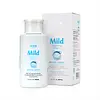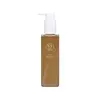What's inside
What's inside
 Key Ingredients
Key Ingredients

 Benefits
Benefits

 Concerns
Concerns

No concerns
 Ingredients Side-by-side
Ingredients Side-by-side

Water
Skin ConditioningButylene Glycol
HumectantPEG-6 Caprylic/Capric Glycerides
EmulsifyingDipropylene Glycol
HumectantPhenoxyethanol
PreservativeSodium Citrate
BufferingHydrogenated Lecithin
EmulsifyingAmaranthus Caudatus Seed Extract
Skin ConditioningUlmus Davidiana Root Extract
Skin ConditioningCentella Asiatica Extract
CleansingFicus Carica Fruit Extract
HumectantAnthemis Nobilis Flower Water
MaskingCamellia Sinensis Leaf Water
MaskingLippia Citriodora Leaf Extract
AstringentPhellinus Linteus/Rice Ferment Extract
EmollientAlthaea Officinalis Leaf/Root Extract
EmollientAnthemis Nobilis Flower Extract
MaskingFoeniculum Vulgare Fruit Extract
EmollientHouttuynia Cordata Extract
Skin ConditioningLavandula Angustifolia Extract
Skin ConditioningOcimum Basilicum Flower/Leaf Extract
TonicRosmarinus Officinalis Leaf Extract
AntimicrobialCitrus Madurensis Fruit Extract
Skin ConditioningCitric Acid
BufferingDisodium EDTA
Ethylhexylglycerin
Skin ConditioningParfum
MaskingCeramide NP
Skin ConditioningPyrus Malus Fruit Water
MaskingWater, Butylene Glycol, PEG-6 Caprylic/Capric Glycerides, Dipropylene Glycol, Phenoxyethanol, Sodium Citrate, Hydrogenated Lecithin, Amaranthus Caudatus Seed Extract, Ulmus Davidiana Root Extract, Centella Asiatica Extract, Ficus Carica Fruit Extract, Anthemis Nobilis Flower Water, Camellia Sinensis Leaf Water, Lippia Citriodora Leaf Extract, Phellinus Linteus/Rice Ferment Extract, Althaea Officinalis Leaf/Root Extract, Anthemis Nobilis Flower Extract, Foeniculum Vulgare Fruit Extract, Houttuynia Cordata Extract, Lavandula Angustifolia Extract, Ocimum Basilicum Flower/Leaf Extract, Rosmarinus Officinalis Leaf Extract, Citrus Madurensis Fruit Extract, Citric Acid, Disodium EDTA, Ethylhexylglycerin, Parfum, Ceramide NP, Pyrus Malus Fruit Water
Water
Skin ConditioningCoco-Betaine
CleansingGlycerin
HumectantCoco-Glucoside
CleansingDecyl Glucoside
Cleansing1,2-Hexanediol
Skin ConditioningDipropylene Glycol
HumectantNiacinamide
SmoothingButylene Glycol
HumectantXanthan Gum
EmulsifyingPanthenol
Skin ConditioningCellulose Gum
Emulsion StabilisingEthylhexylglycerin
Skin ConditioningSodium Polyacrylate
AbsorbentPropanediol
SolventCitric Acid
BufferingSorbitol
HumectantCamellia Sinensis Leaf Powder
ExfoliatingDisodium EDTA
Allantoin
Skin ConditioningHyaluronic Acid
HumectantHydrolyzed Hyaluronic Acid
HumectantSodium Hyaluronate
HumectantCaprylic/Capric Triglyceride
MaskingSaccharomyces/Xylinum/Black Tea Ferment
Skin ConditioningCeramide NP
Skin ConditioningHydrogenated Lecithin
EmulsifyingWater, Coco-Betaine, Glycerin, Coco-Glucoside, Decyl Glucoside, 1,2-Hexanediol, Dipropylene Glycol, Niacinamide, Butylene Glycol, Xanthan Gum, Panthenol, Cellulose Gum, Ethylhexylglycerin, Sodium Polyacrylate, Propanediol, Citric Acid, Sorbitol, Camellia Sinensis Leaf Powder, Disodium EDTA, Allantoin, Hyaluronic Acid, Hydrolyzed Hyaluronic Acid, Sodium Hyaluronate, Caprylic/Capric Triglyceride, Saccharomyces/Xylinum/Black Tea Ferment, Ceramide NP, Hydrogenated Lecithin
 Reviews
Reviews

Ingredients Explained
These ingredients are found in both products.
Ingredients higher up in an ingredient list are typically present in a larger amount.
Butylene Glycol (or BG) is used within cosmetic products for a few different reasons:
Overall, Butylene Glycol is a safe and well-rounded ingredient that works well with other ingredients.
Though this ingredient works well with most skin types, some people with sensitive skin may experience a reaction such as allergic rashes, closed comedones, or itchiness.
Learn more about Butylene GlycolCeramide NP is a type of ceramide and formally known as ceramide 3.
Ceramides are intercellular lipids naturally found in our skin that bonds dead skin cells together to create a barrier. They are known for their ability to hold water and thus are a great ingredient for dry skin.
Ceramides are an important building block for our skin barrier. A stronger barrier helps the skin look more firm and hydrated. By bolstering the skin ceramides act as a barrier against irritating ingredients. This can help with inflammation as well.
If you would like to eat ceramides, sweet potatoes contain a small amount.
Read more about other common types of ceramides here:
Ceramide AP
Ceramide EOP
Citric Acid is an alpha hydroxy acid (AHA) naturally found in citrus fruits like oranges, lemons, and limes.
Like other AHAs, citric acid can exfoliate skin by breaking down the bonds that hold dead skin cells together. This helps reveal smoother and brighter skin underneath.
However, this exfoliating effect only happens at high concentrations (20%) which can be hard to find in cosmetic products.
Due to this, citric acid is usually included in small amounts as a pH adjuster. This helps keep products slightly more acidic and compatible with skin's natural pH.
In skincare formulas, citric acid can:
While it can provide some skin benefits, research shows lactic acid and glycolic acid are generally more effective and less irritating exfoliants.
Most citric acid used in skincare today is made by fermenting sugars (usually from molasses). This synthetic version is identical to the natural citrus form but easier to stabilize and use in formulations.
Read more about some other popular AHA's here:
Learn more about Citric AcidDipropylene Glycol is a synthetically created humectant, stabilizer, and solvent.
This ingredient helps:
Dipropylene glycol is technically an alcohol, but it belongs to the glycol family (often considered part of the ‘good’ alcohols). This means it is hydrating and gentle on skin unlike drying solvent alcohols like denatured alcohol.
As a masking agent, Dipropylene Glycol can be used to cover the smell of other ingredients. However, it does not have a scent.
Studies show Dipropylene Glycol is considered safe to use in skincare.
Learn more about Dipropylene GlycolDisodium EDTA plays a role in making products more stable by aiding other preservatives.
It is a chelating agent, meaning it neutralizes metal ions that may be found in a product.
Disodium EDTA is a salt of edetic acid and is found to be safe in cosmetic ingredients.
Learn more about Disodium EDTAEthylhexylglycerin (we can't pronounce this either) is commonly used as a preservative and skin softener. It is derived from glyceryl.
You might see Ethylhexylglycerin often paired with other preservatives such as phenoxyethanol. Ethylhexylglycerin has been found to increase the effectiveness of these other preservatives.
Hydrogenated Lecithin is created from the hydrogenation of lecithin (a group of phospholipids). Hydrogenation is a chemical reaction between hydrogen and another element.
This ingredient is an emollient and emulsifier. As an emollient, it helps soften skin by trapping moisture within. As an emulsifier, it prevents oil and water ingredients from separating.
Water. It's the most common cosmetic ingredient of all. You'll usually see it at the top of ingredient lists, meaning that it makes up the largest part of the product.
So why is it so popular? Water most often acts as a solvent - this means that it helps dissolve other ingredients into the formulation.
You'll also recognize water as that liquid we all need to stay alive. If you see this, drink a glass of water. Stay hydrated!
Learn more about Water